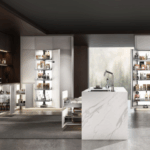Staying Safe and Healthy Indoors | Panasonic
In 2020, many Australians experienced an earlier shift to indoor living compared to previous winter seasons.
Driven by the Federal Government’s protective measures due to the ongoing COVID-19 crisis, we spent more time discovering books, board games and hobbies such as baking during extended periods in the home.

GALLERY
And although we see Australia as a nation of the great outdoors, a recent university study shows that in fact we spend 90 per cent of our time indoors.

Health Risks Associated with the Home
As the colder weather now sets in, many of us are shutting doors and windows and turning on the heating to get warm, cosy and comfortable. However, there are some potentially serious health risks associated with restricted air flow in an indoor environment that we should all be wary of.
When fresh air doesn’t have the chance to circulate through the home, this can lead to the accumulation of allergens, mould, bacteria, and viruses.[1] The presence of these particles in the air and on surfaces could harm our health, at a time when we’re spending more time at home than ever before.
A lack of ventilation during the onset of the winter flu season can also result in the increased presence and survival of bacteria as well as the concentration of common viruses in the air.[2] These detrimental factors also present a particular risk to people with respiratory conditions; including those 2.7 million Australians who are asthmatics.[3]
Although not necessarily a danger to health, household odours from food or pets collecting in stale indoor air also creates an unpleasant environment.

In addition, recognising the significant impact on our health, the Australian Government has moved to provide outdoor air quality readings. Particle levels can be elevated even in cooler months, through smoke from hazard reduction burning and wood heating. During these environmental conditions, good air quality inside the home is a must.

Creating a clean living environment
Research from the Australian Bureau of Statistics (ABS)[4] states that nearly half (49%) of Australian households use a reverse cycle air conditioning unit as their main system of cooling and heating.
Considering the average person breathes in 18kg of air every day[5], and what we now know about the invisible dangers to health in the home, it’s vital to have an air conditioner that creates a comfortable climate while also cleverly cleaning air.

With this in mind, Panasonic has developed an air conditioner with a built-in air purifier.
The revolutionary nanoe™ X air purifying system actively cleans the air within the room, creating a fresher and healthier living environment by using water molecules filled with OH radicals to neutralise micro-organisms – inhibiting 99 per cent of airborne bacteria, viruses and mould. As well as cleaning airborne impurities, these molecules also offer adhesive inhibition of 99% of bacteria and viruses on surfaces.

In fact, a recent test commissioned by Japan’s Kitasato Research Centre for Environmental Science revealed nanoe™ X technology was successful in eradicating 99.9 per cent of an influenza virus in an air-tight room, and 99.7 per cent of a superbug in a similar test.[6]
Allergens that can affect asthma sufferers, such as pollen, pet dander and mite droppings, are also inhibited by nanoe™ X.

Adele Taylor, Sensitive Choice Program Manager, National Asthma Council Australia, said: “With one in nine Australians having asthma, it is crucial that companies design and develop products and services that keep those 2.7 million people in mind. Panasonic’s nanoe™X purification solution has been rigorously reviewed by our expert product advisory panel, and proven to potentially benefit those with asthma or allergies.”
For total peace of mind that harmful irritants are being removed from the home this winter season, Panasonic’s two-in-one nanoe™X Air Purifying System continues to purify and deodorise air even when cooling or heating is not in operation, minimising energy consumption while providing a cleaner, healthier, sweet-smelling home.
For more information
[1] World Health Organisation: Guidelines for indoor air quality – Dampness and mould. https://apps.who.int/iris/bitstream/10665/164348/1/E92645.pdf
[2] Nikitin N, Petrova E, Trifonova E, Karpova O.. Influenza virus aerosols in the air and their infectiousness. https://www.ncbi.nlm.nih.gov/pmc/articles/PMC7153836/
[3] Asthma Australia 2020, https://asthma.org.au/about-asthma/understanding-asthma/statistics/
[4] ABS 2015, https://www.abs.gov.au/ausstats/abs@.nsf/mf/4602.0.55.001
[5] Department of Occupational Health, National Institute of Public Health 1999, https://ci.nii.ac.jp/naid/110008447936
[6] Straits Times 2020, https://www.straitstimes.com/business/demand-up-for-clean-air-air-cons
The secret to a minimalist kitchen is having a space to hide everything away – as the kitchen ...
Staron® creates a sweet experience for customers indulging in the delights of Joli. Staron® Solid Surfaces were selected for ...
A new hospitality project known as the Hermit Resort has taken shape beside one of China’s significant archaeological ...
Eindhoven has a striking new addition to its skyline with the completion of Lighthouse, a 109 metre residential ...
A striking red staircase has become the symbolic thread connecting two NAB workplaces located 24 kilometres apart, with ...














